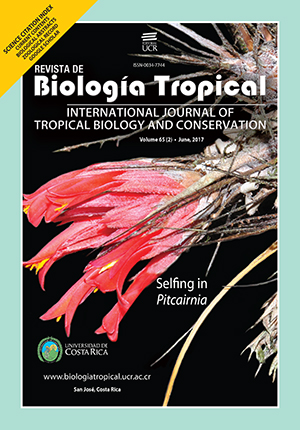Abstract
Lepidaploa rufogrisea is a promising candidate in the search of natural herbicides, with compounds (sesquiterpene lactones-glaucolide B) which have been reported to present with phytotoxic potential against weeds. Thus, this work aimed to accomplish the phytochemical investigation of L. rufogrisea as well as the evaluation of its biological effects on the plant model Lactuca sativa. To this end, different extracts (aqueous, hydroalcoholic and hexane) of L. rufogrisea at different concentrations [0.25, 0.5, 1.0, 2.0 and 4.0 % (m/v)] were evaluated from macroscopic (percentage of germinated seeds, germination speed index and root length) and microscopic analysis (mitotic index and cell cycle alterations) in plantlets (150 per treatment) and meristematic cells (10 000 per treatment) of L. sativa var. Cristina. The extracts decreased the germination speed index and also the root growth of L. sativa plantlets. Cell proliferation was not significantly affected by the extracts. However, some chromosome and nuclear alterations in the mitotic spindle were observed, due to the interference of allelochemicals present in L. rufogrisea. Moreover, the plant model L. sativa demonstrated to be efficient for this kind of studies.
References
Almeida, A. B. A., Miotto, A. M., Nunes, D. S., Spadari-Bratifisch, R. C., & Brito, A. R. M. (2002). Mechanism of antiulcerogenic activity of semi-synthetic crotonin obtained from Croton cajucara Benth. Revista Brasileira de Farmacoginosia, 12, 105-110.
Andrade, L. F., Davide, L. C., & Gedraite, L. S. (2010). The effect of cyanide compounds, fluorides and inorganic oxides present in spent pot liner on germination and root tip cells of Lactuca sativa. Ecotoxicology and Environmental Safety, 73, 626-631.
Andrade-Vieira, L. F. (2012). In G. B. C. Cabral & B. A. E. Botehlho (Eds.), Landfills: Waste Management, Regional Practices and Environmental Impact (pp. 319-330). New York, USA: Nova Science Publishers.
Andrade-Vieira, L. F., Botelho, C. M., Palmieri, M. J., Laviola, B. G., & Praça-Fontes, M. M. (2014). Effects of Jatropha curcas oil in Lactuca sativa root tip bioassays. Academia Brasileira de Ciências, 86(1), 373-382.
Aragão, F. B., Palmieri, M. J., Ferreira, A., Costa, A. V., Queiroz, V. T., Pinheiro, P. F., & Andrade-Viera, L. F. (2015). Phytotoxic and cytotoxic effects of Eucalyptus essential oil on Lactuca sativa L. Allelopathy Journal, 35, 259-272.
Bachelier, A., Mayerb, R., & Kleina, C. D. (2006). Sesquiternes lactones are potent and irreversible inhibitors of the antibacterial target enzyme MurA. Bioorganic & Medicinal Chemistry Letters, 16, 5605-5609.
Campos, J. M. S., Davide, L. C., Soares, G. L. G., & Viccini, L. F. (2008). Mutagenic effects due to allelopathic action of fern (Gleicheniaceae) extracts. Allelopathy Journal, 22(1), 143-152.
Chadwick, M., Trewin, H., Gawthrop, F., & Wagstaff, C. (2013). Sesquiterpenoids Lactones: Benefits to Plants and People. Internation Journal of Molecular Sciences, 14(6),12780-12805.
Grant, W. F. (1994). The present status of higher plant bioassay for detection of environmental mutagens. Mutation Researche, 310(2), 175-185.
Harashima, H., & Schnittger, A. (2010). The integration of cell division, growth and differentiation. Current Opinion in Plant Biology, 13, 66-74.
Hussain, M. I., & Reigosa, M. J. (2014). Evaluation of herbicide potential of sesquiterpene lactone and flavonoid: impact on germination, seedling growth indices and root length in Arabidopsis thaliana. Journal of Botany, 46(3), 995-1000.
Isman, M. B. (2006). Plant essential oils for pest and disease management. Annual Review Entomology, 51, 45-56.
Kato-noguchi, H., Takeshita, S., Kimura, F., Ohno, O., & Suenaga, K. (2013). A novel substance with allelopathic activity in Ginkgo biloba. Journal of Plant Physiology, 170, 1595-1599.
Leme, D. M., & Marin-Morales, M. A. (2009). Allium cepa test in environmental monitoring: A review on its application. Mutation Research, 682, 71-81.
Li, H. H., Inoue, M., Nishimura, H., Mizutani, J., & Tsuzuki, E. (1993). Interaction of trans-cinnamic acid, its related phenolic allelochemicals, and abscisic-acid in seedling growth and seed-germination of lettuce. Journal of Chemical Ecology, 19, 1775-1787.
Li, Z. H., Wang, Q., Ruan, X., Pan, C. D., & Jiang, D. A. (2010). Phenolics and plant allelopathy. Molecules, 15, 8933-8952.
Macias, F. A., Torres, A., Molinllo, J. M. G., Varela, R. M., & Castellano, D. (1996). Potential allelopathic sesquiterpene lactones from sunflower leaves. Phytochemistry, 43, 1205-1215.
Macias, F. A., Varela, R. M., Torres, A., Oliva, R. M., & Molinillo, J. M. G. (1998). Bioactive norsesquiterpenes from Helianthus annuuswith potential allelopathic activity. Phytochemistry, 48, 631-636.
Matos, F. J. A. (2009). Introdução à Fitoquímica Experimental (3ª ed.). Fortaleza: UFC.
Narwal, S. S. (1999). Allelopathy Update, Basic and Applied Aspects. Enfield, NH: Science Publisher.
Padolina, W. G., Yoshioka, H., Nakatani, N., Mabry, T. J., Monti, A. S., Davis, R. E., Cox, P. J., Sim, A. O., Watson, W. H., & Beth, W. I. (1974). Glaucolide -A and -B, new germacrano- lide-type sesquiterpene lactones from Vernonia (Compositae). Tetrahedron, 30, 1161-1170.
Rice, E. L. (1984). Allelopathy (2 ed.). Orlando, USA: Academic Press.
Sousa, M. S., Silva, O. S, Campos, J. M. S., & Viccini, L. F. (2009). Cytotoxic and genotoxic effects of two medicinal species of Verbenaceae. Caryologia, 62(4), 326-333.
Souza Filho, A. P. S., Lobo, L. T., & Arruda, M. S. P. (2005). Atividade alelopática de Tachigali myrmecophyla. Planta Daninha, 23, 557-564.
Spargh, S. G., Light, M. E., & Van Staden, J. (2004). Biological activities and distribution of plant saponins. Journal of Ethnopharmacology, 94, 219-243.
Taiz, L. & Zeiger, E. (2013). Fisiologia vegetal (5a ed.). Porto Alegre: Artmed.
Vermes, I., Haanen, C., & Reutelingsperger, C. (2000). Flow cytometry of apoptotic cell death. Journal of Immunological Methods, 243, 67-190.
Wedge, D. E., Galindo, J. C. G., & Macías, F. A. (2000). Fungicidal activity of natural and synthetic sesquiterpene lactone analogs. Phytochemistry, 53, 747-757.
Zeng, R. S., Luo, S. M., & Shi, Y. H. (2001). Physiological and biochemical mechanism of allelopathy of secalonic acid on higher plants. Agronomy Journal, 93, 72-79.
##plugins.facebook.comentarios##

This work is licensed under a Creative Commons Attribution 4.0 International License.
Copyright (c) 2017 Revista de Biología Tropical






